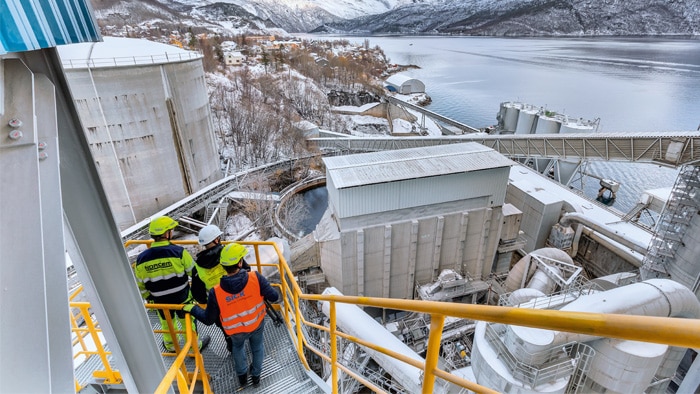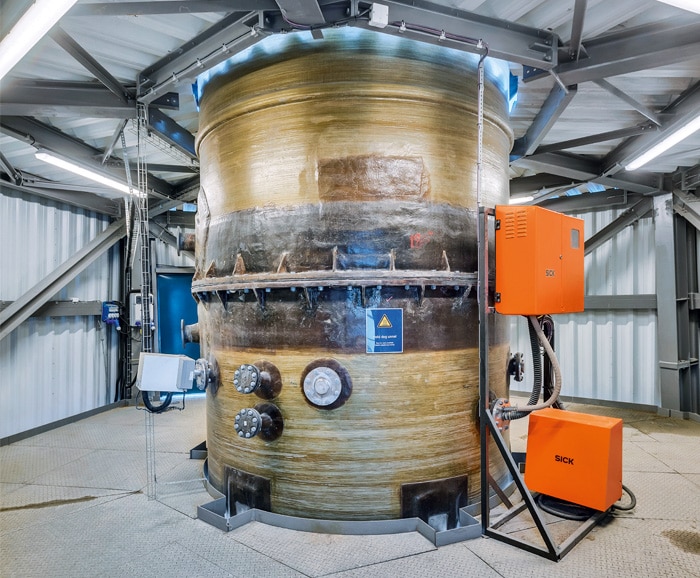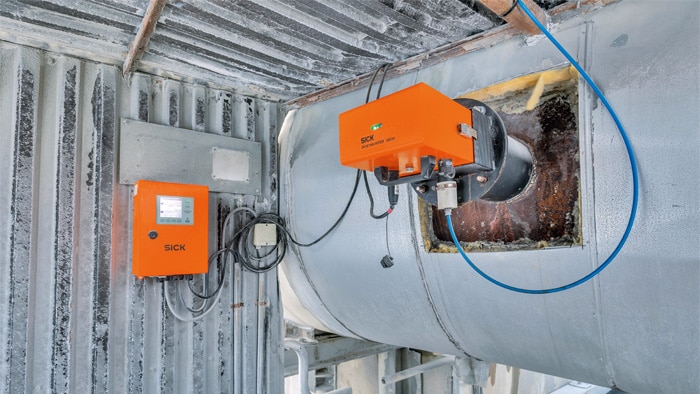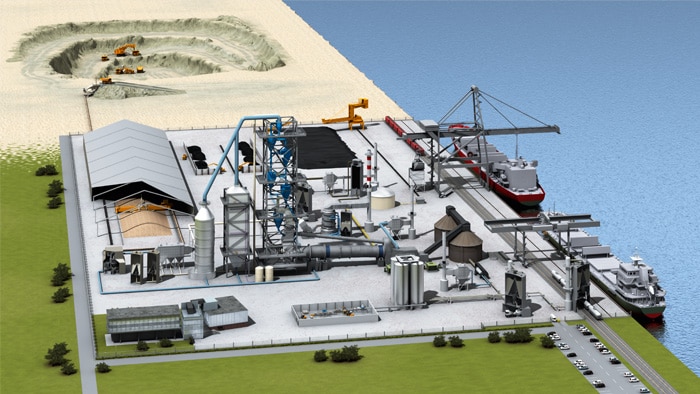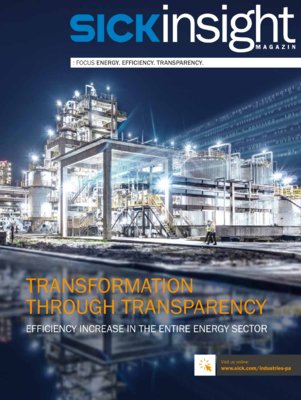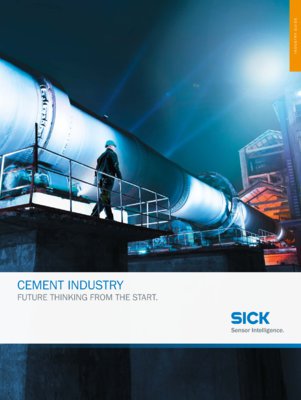The Norwegian cement manufacturer Norcem, a member of the worldwide group HeidelbergCement, wants to do more for the environment and emit even fewer pollutants. To ensure that everything is done in accordance with legal requirements for low limit values, innovative dust measurement devices from SICK perform a decisive measuring task after the flue gas scrubber. Only when the plant operator Norcem Kjøpsvik is satisfied the high requirements are fulfilled.
Norcem cement plant: Measuring dust at its best
Water droplets or dust particles? Only excellent vision can tell them apart. Humanly impossible? That's why there are measuring instruments that are specialized in measuring dust concentrations in wet gas. However, not all dust measuring devices control reliably to ensure that the emission limits can be compliant. The exhaust gas after scrubber systems is usually very cold and saturated with water. This fact challenges the measuring technology.
Great things are being done in the Arctic Circle. In the middle of the harsh Norwegian remoteness, the world's northernmost cement plant – and the only one within a radius of 1,000 km – is taking on a remarkable task. Norcem Kjøpsvik produces cement for the domestic market. This is often not easy. The routes toward 68 degrees north are cumbersome and time-consuming. Because of the distance alone, the process chain and equipment must function perfectly. In addition, the sulphurous limestone has caused problems in the past. The sulphur content was too high and the plant increasingly exceeded the permitted emission limits. The limestone was extracted from the adjacent quarry. This meant short distances that made economic sense. Now a constructive rethink was called for. First of all, Norcem changed its mining plan and extracted low-sulphur limestone from other areas, which significantly extended the transport distances. In the long term, this was not a sustainable change and therefore only a temporary solution. The situation transformed abruptly, however, when Norcem was able to invest in a flue gas desulphuristation (FGD) plant based on a seawater scrubber with the support of the state environmental fund Miljøfondet. This technology was used to remove SO2 from the flue gas with a high separation rate. This made lime mining in the adjacent limestone quarry possible again. Since then, the dust sensor technology from SICK has been measuring concentrated in the wet gas, confirming Norcem Kjøpsvik's emission limits, which are now in the green range.
Emission Reporting
Clean exhaust gas and compliant emission limit values are the cornerstones of success. The gas cleaning system was ready for operation in short time. The contract with the equipment supplier was signed in autumn 2017, installation work began in summer 2018 and hot commissioning took place in May 2019. In the meantime, more than 95% of the sulphur dioxide is washed out. The maximum SO2 concentration at the stack outlet is limited to < 50 mg/m³, which is an excellent value. The plant uses only seawater instead of chemical absorbents. However, this challenges the continuous dust concentration measurement. What is a water droplet? What is a dust particle? In the wet gas duct, it is indistinguishable for standard devices. Accordingly, the inaccurately measured values of such devices are also unacceptable for emission reporting. The measurement performance of the dust monitor from SICK, on the other hand, is light years ahead of the standard, because the FWE200DH is designed especially for difficult measurement conditions such as these.
Measuring dust at its best
According to the optical principle, the scattered light intensity determines the dust concentration. Disturbing water droplets must be removed before the measurement. The FWE200DH extracts sample gas from the exhaust gas flow. In the bypass system, the water droplets evaporate so that they no longer hinder the accurate measurement. The exhaust gas flows back into the gas duct after the measurement. The FWE200DH measures in many applications and industries worldwide, but the special installation conditions at Norcem Kjøpsvik were a new challenge for SICK's particle analyzer team. The tight geometric space conditions in the mounting flange made the use of a usual measuring gas probe for exhaust gas extraction impossible. For correct functioning, the sample gas probe must be mounted facing downwards, which would not have been possible with a standard probe design. This hurdle could only be overcome with a customer-specific probe geometry provided by SICK. During commissioning, it became apparent that the sample gas probe could be mounted without any problems. This made it possible to link the functional requirements with the real installation conditions. The facility is still running smoothly and reliably today.
Some dust hunters like it wet... and some like it dry
In addition to the high sulphur volatiles from the raw material, the high chlorine input from alternative fuels also causes problems in cement production.
Not only sulphur volatile gases are relevant to the climate. In raw material and fuel there are many pollutants which are released by the pyro process. In addition to the high proportion of sulphur volatiles from the raw material, the high chlorine input from alternative fuels also causes problems in cement production. Switching to alternative fuels with biomass reduces carbon dioxide emissions, but in return usually increases the chlorine input and the risk of blockages in the cyclones. To ensure that the preheater functions without restrictions, a bypass system extracts up to 60% of the process gas. This removes gas components that disturb the process from the pyro process. This gas stream is later fed back into the process where the raw meal is added. In normal operation Norcem operates the bypass with less than 10% of the exhaust gas volume.
Fabric filters are a particularly efficient and frequently used filter technology. The dust-laden flue gas flows into the filter chamber and passes through several filter bags. The coarse particles fall by gravity into the hopper. The fine particles accumulate on the surface of the permeable filter medium and form a layer of dust, usually called filter cake. Compressed air periodically cleans this filter cake. However over time, small holes can form in the fabric. As a result, the gas enters the exhaust air unfiltered and worsens the emission limits.
Measuring dust with comfortable ease
To prevent this from happening the DUSTHUNTER SB30 measures after the filter of the bypass. The dust measuring device reports in real time, signaling when filters are damaged. The scattered light measuring principle − in this case with backward scattering − monitors constantly and is not influenced by the flow speed or the dust particle charge. This is an important advantage over other measuring methods, such as the triboelectric principle. The self-monitoring function is particularly user-friendly. Automatic test cycles reduce maintenance requirements and ensure that processes run smoothly. Norcem Kjøpsvik also found installation and commissioning to be effortless. After a few hours, the DUSTHUNTER was ready to start working. The dust measuring device was mounted on the exhaust duct on one side only. The additional effort for special alignments, as required for cross-channel transmission dust analyzers, was completely eliminated. Since this DUSTHUNTER SB30 has no measuring probe, so that a longer instrument lifetime is guaranteed. This is because aggressive gases would attack a probe and corrosion and abrasion would be the result.
The significantly higher detection sensitivity of the DUSTHUNTER SB30, combined with the cost-effective installation and maintenance, is the recipe for success across the board: increased performance with reduced total costs over the entire life cycle of the device.
The efficiency and profitability of the plant in Kjøpsvik has increased significantly – not only at the heat exchanger but in the entire exhaust gas cleaning system. Years earlier, SICK had already supplied gas analyzers for the rotary kiln of Norcem Kjøpsvik. Out of conviction, Norcem also decided to use dust measurement technology from SICK. Erik Nilsen, Maintenance Manager NORCEM AS: "Regarding the dust analyzers, there is not much to say. We oversee the equipment every fourth week and we haven't had a single problem since we installed them."
Read more:
Feeding bulk materials on a running belt: Dosage and mix must be right
Controlling NOx effectively: SICK supports the optimization of DeNOx plants
Gas and dust measurement: limiting explosions
Measuring dust emissions - can this also be done easily?
Cement plant in the desert is equipped with SICK sensors
